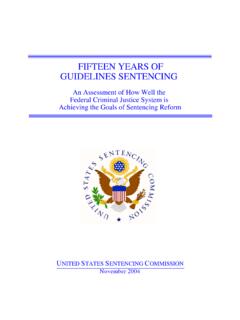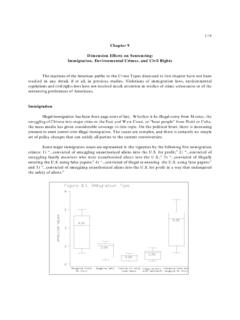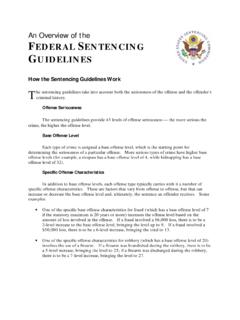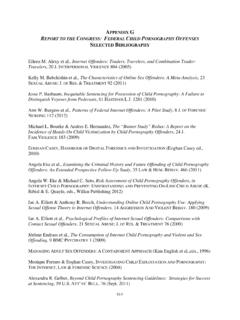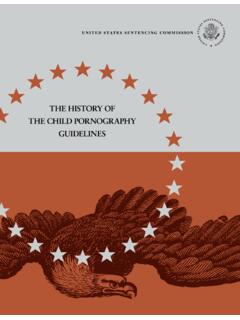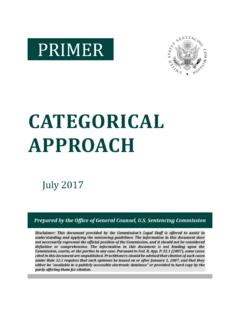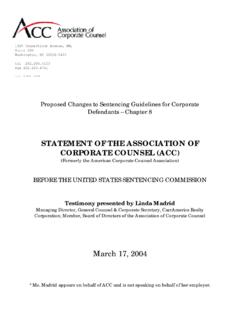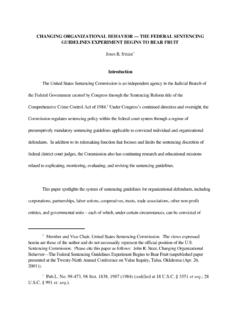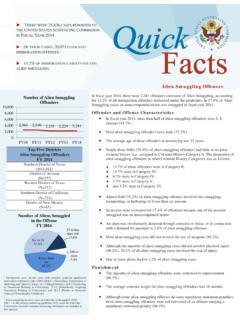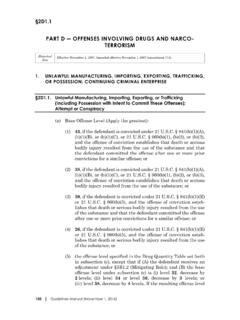Transcription of An Overview of the Organization Guidelines
1 Organizations, like individuals, can be found guilty ofcriminal conduct, and the measure of theirpunishment for felonies and Class A misdemeanors isgoverned by Chapter Eight of the sentencing Guidelines . While organizations cannot be imprisoned, they can befined, sentenced to probation for up to five years, orderedto make restitution and issue public notices of convictionto their victim and exposed to applicable forfeiturestatutes. Data collected by the Sentencing Commissionreflect that organizations are sentenced for a wide range ofcrimes. The most commonly occurring offenses (in orderof decreasing frequency) are fraud, environmental wastedischarge, tax offenses, antitrust offenses, and food anddrug organizational sentencing Guidelines (whichapply to corporations, partnerships, labor unions, pensionfunds, trusts, non-profit entities, and governmental units)became effective November 1, 1991, after several years ofpublic hearings and analyses.
2 These Guidelines aredesigned to further two key purposes of sentencing: justpunishment and deterrence. Under the justpunishment model, the punishment corresponds to thedegree of blameworthiness of the offender, while underthe deterrence model, incentives are offered fororganizations to detect and prevent Compliance Programs Criminal liability can attach to an organizationwhenever an employee of the Organization commits an actwithin the apparent scope of his or her employment, evenif the employee acted directly contrary to company policyand instructions. An entire Organization , despite its bestefforts to prevent wrongdoing in its ranks, can still be heldcriminally liable for any of its employees illegal actions. Consequently, when the Commission promulgated theorganizational Guidelines , it attempted to alleviate theharshest aspects of this institutional vulnerability byincorporating into the sentencing structure the preventiveand deterrent aspects of systematic compliance programs.
3 The Commission did this by mitigating the potential finerange - in some cases up to 95 percent - if an organizationcan demonstrate that it had put in place an effectivecompliance program. This mitigating credit under theguidelines is contingent upon prompt reporting to theauthorities and the non-involvement of high levelpersonnel in the actual offense Eight outlines seven key criteria forestablishing an effective compliance program :Compliance standards and procedures reasonablycapable of reducing the prospect of criminal activity COversight by high-level personnelCDue Care in delegating substantial discretionaryauthorityCEffective Communication to all levels ofemployeesCReasonable steps to achieve compliance, whichinclude systems for monitoring, auditing, andreporting suspected wrongdoing without fear ofreprisalCConsistent enforcement of compliancestandards including disciplinary mechanismsCReasonable steps to respond to and preventfurther similar offenses upon detection of aviolationThe organizational Guidelines criteria embodybroad principles that, taken together, describe acorporate good citizenship model, but do not offerprecise details for implementation.
4 This approach wasdeliberately selected in order to encourage flexibility andindependence by organizations in designing programsthat are best suited to their particular Best Practices IdeasThe innovative approach put forward in thesentencing Guidelines has spawned complementaryefforts by a number of regulatory and law enforcementauthorities, Executive agencies such as theEnvironmental Protection Agency, the Department ofHealth and Human Services, and the Department ofJustice s Antitrust Division have developed, or aredeveloping model compliance programs, programs forself-reporting, and programs for amnesty - all of whichare modeled after some aspect of the organizationalsentencing Guidelines . Industry and peer organizationsare forming to share ideas on best practices forcompliance training and ethics Commission will continue to study theeffectiveness of these efforts to implement thecompliance criteria of Chapter Eight. In particular, theCommission is interested in assessments of the viabilityof its efforts to encourage organizations - from largecorporations to non-profits organizations togovernmental units - to develop institutional culturesthat discourage criminal conduct.
5 #For more information, contact the United States SentencingCommission, One Columbus Circle, , Suite 2-500,Washington, DC : 202-502-4500; FAX: 202-502-4699An Overview of the Organizational GuidelinesPaula Desio, Deputy General Counsel, United States Sentencing Commissio
